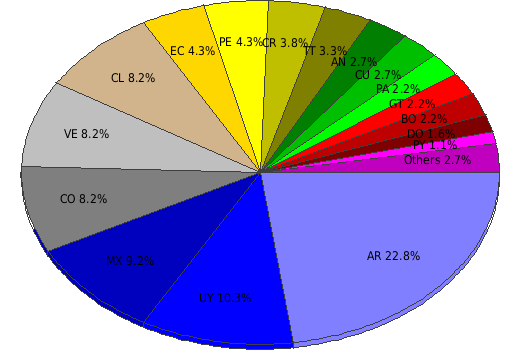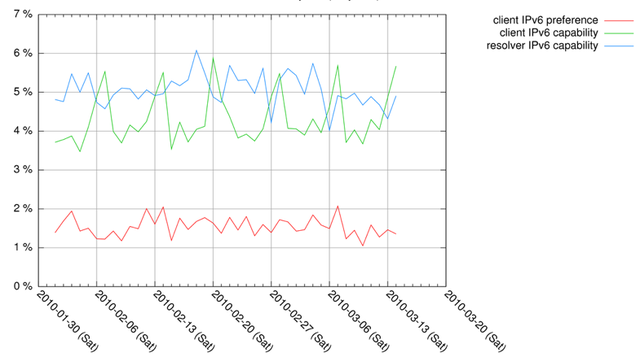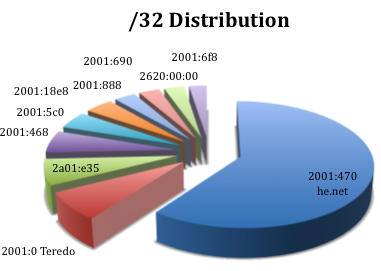This is the second part of a compilation of IPv6 measurements produced by various organisations and individuals, including links to their measurements, explanations of their methods and the results of their studies.
At the end of last year we published a list of IPv6 measurements produced by various organisations and individuals, including links to their measurements, explanations of their methods and the results of their studies. In the meantime, we found out about some other measurements that should be included in this list. Please find below Part 2 of the IPv6 measurements compilation.
- Arbor Networks (1)
- Arbor Networks (2)
- ARIN
- IPv6 Darknet
- Dan Wing, Cisco
- Olivier Crepin-Leblond, Global Information Highway (GIH)
- LACNIC
- RIPE NCC
- SANS Internet Storm Center
1. Arbor Networks (1)
The URL below points to a report showing results of a year-long research project. It provides a global perspective on the amount of IPv6 traffic on the Internet. In order to receive a free copy of the pdf you have to register on the site.
The amount of aggregate inter-domain IPv6 Internet traffic appears to be increasing. However, the proportion of IPv6 vs. IPv4 traffic has stayed roughly the same over the last year.
http://www.arbornetworks.com/en/ipv6-report.html
2. Arbor Networks (2) 
There is also a blog maintained by Jose Nazario, who recently started collecting IPv6 DNS traffic in a passive DNS monitor. In summary, IPv6 deployment is growing and DNS is an interesting way to see where it’s in use. Details can be found here:
http://asert.arbornetworks.com/2010/06/ipv6-dns-statistics/
3. ARIN
The ARIN IPv6 wiki shows a list of IPv6 measurements from various sources:
http://www.getipv6.info/index.php/IPv6_Penetration_Survey_Results
4. IPv6 Darknet
Matthew Ford, Jonathan Stevens and John Ronan set up a darknet in 2006 to observe the ‘noise’ present on the IPv6 Internet and see how this differs from the IPv4 Internet. The results were published in the paper linked below. The darknet is still running today.
http://www.computer.org/portal/web/csdl/doi/10.1109/ICISP.2006.14
5. Dan Wing, Cisco
Dan Wing has been looking at AAAA and IPv6 connectivity statistics of top websites (based on Alexa data). This is comparable to some of the measurements described in the RIPE Labs IPv6 Measurements Compilation Part 1.
http://banjo.employees.org/~dwing/aaaa-stats.html
6. Olivier Crepin-Leblond, Global Information Highway (GIH)
Olivier Crepin-Leblond analysed IPv6 traffic based on measurements supplied by VeriLAN Event Services during ICANN meetings in Sydney in June 2009 and Seoul in October 2009. The rationale behind this was that an ICANN meeting could be assumed to be a microcosm of the whole Internet. It is interesting to observe a trend of increasing IPv6 traffic:
- In June 2009, IPv6 traffic came to 0.175% of total traffic carried during the conference;
- In October 2009, IPv6 traffic rose to 0.826% of total traffic carried.
Less than one percent is not much. However, the important fact is that IPv6 traffic multiplied 4.5 fold in four months. You can see more details here:
ICANN Meeting in Sydney in June 2009 , ICANN Meeting in Seoul in October 2009 .
Unfortunately there were no measurements taken at the ICANN meeting in Nairobi in March 2010, but he is hoping to be able to collect data at the ICANN meeting in Brussels.
7. LACNIC 
LACNIC has been performing IPv6 measurements for some time, based on IPv6 addresses allocated by LACNIC and the other RIRs. You can also find information about IPv6 allocations per country in the LACNIC service region.
http://portalipv6.lacnic.net/en/ipv6/statistics
8. RIPE NCC (web clients and resolver measurements)

Emile Aben from the RIPE NCC has written a JavaScript that measures the IPv4 capability, IPv6 capability and the IPv4/IPv6 preference of End Users visiting www.ripe.net . What is unique about this script is that it also allows measurement of the caching DNS resolver that the End User system is using.
These measurements have been running since January 2010 and the results show that the number of IPv6-enabled clients is lagging behind the number of resolvers that are IPv6 capable. It is also interesting to note that the percentage of IPv6 capable clients and resolvers connecting to labs.ripe.net is higher than those connecting to www.ripe.net. There are three parts to these measurements: Part 1 provides an overview, Part 2 shows some more detailed statistics and Part 3 explains the methodology used.
http://labs.ripe.net/content/measuring-ipv6-web-clients-and-caching-reso...
9. SANS Internet Storm Center 
Johannes Ullrich from the SANS Technology Institute analysed IPv6 traffic sent to isc.sans.org over the last three months of 2009. The report shows that IPv6 is still used by only 1.3% of hosts connecting to isc.sans.org. However, this is a considerable increase from about a year ago, when it was about 0.5%. The overwhelming use of tunnels suggests that most, if not all of these users would be able to reach isc.sans.org via IPv4 more quickly, because setting up a tunnel connection adds extra latency. The full report can be downloaded as a pdf document on the site below.
http://isc.sans.org/diary.html?storyid=7948





Comments 0
The comments section is closed for articles published more than a year ago. If you'd like to inform us of any issues, please contact us.